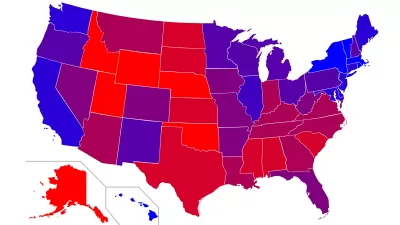After the bust of the housing market in 2008, a striking reversal of settlement patterns in New Jersey gives cities the lead in population growth over once-booming suburbs and exurbs.
Echoing trends seen across the U.S., Tim Evans, of New Jersey Future, writes on New Jersey's changing growth patterns. "Measured any of several ways," he reports, "the pattern is clear: Between 2008 and 2011, older, more urbanized, more built-out municipalities generally grew faster than less-developed suburban, exurban, and rural municipalities."
This data comes in the face of decades of population loss for many of New Jersey's inner cities, which continued their fall between 2000 and 2008, shrinking their share of the state's population from 66.4% in 1940 to 38.3% in 2010, according to the Census Bureau.
But since the housing bubble slowed the flow of population into the suburbs, cities are not only withstanding the economic slowdown, but are growing faster than the rest of the state. "These big cities had not come close to matching the statewide growth rate since before 1930," reports Evans, "They managed this feat by gaining, on average, 17 times as many new residents annually from 2008 to 2011 as they had between 2000 and 2008."
It appears, however, that unlike the nationwide data, a closer look at the absolute numbers confirms the significance of the trend.
"Considering that New Jersey is the most developed state in the nation," argues Evans, "this trend toward redevelopment of already-built areas and away from continued development of a dwindling supply of open land is good news. If any state is in need of a rethinking of the dominant development paradigm – or is better poised to capitalize on the alternative – it is New Jersey."
FULL STORY: Cities (Of All Sizes) Lead the State in Population Growth

Study: Maui’s Plan to Convert Vacation Rentals to Long-Term Housing Could Cause Nearly $1 Billion Economic Loss
The plan would reduce visitor accommodation by 25,% resulting in 1,900 jobs lost.

North Texas Transit Leaders Tout Benefits of TOD for Growing Region
At a summit focused on transit-oriented development, policymakers discussed how North Texas’ expanded light rail system can serve as a tool for economic growth.

Why Should We Subsidize Public Transportation?
Many public transit agencies face financial stress due to rising costs, declining fare revenue, and declining subsidies. Transit advocates must provide a strong business case for increasing public transit funding.

How to Make US Trains Faster
Changes to boarding platforms and a switch to electric trains could improve U.S. passenger rail service without the added cost of high-speed rail.

Columbia’s Revitalized ‘Loop’ Is a Hub for Local Entrepreneurs
A focus on small businesses is helping a commercial corridor in Columbia, Missouri thrive.

Invasive Insect Threatens Minnesota’s Ash Forests
The Emerald Ash Borer is a rapidly spreading invasive pest threatening Minnesota’s ash trees, and homeowners are encouraged to plant diverse replacement species, avoid moving ash firewood, and monitor for signs of infestation.
Urban Design for Planners 1: Software Tools
This six-course series explores essential urban design concepts using open source software and equips planners with the tools they need to participate fully in the urban design process.
Planning for Universal Design
Learn the tools for implementing Universal Design in planning regulations.
City of Santa Clarita
Ascent Environmental
Institute for Housing and Urban Development Studies (IHS)
City of Grandview
Harvard GSD Executive Education
Toledo-Lucas County Plan Commissions
Salt Lake City
NYU Wagner Graduate School of Public Service



























